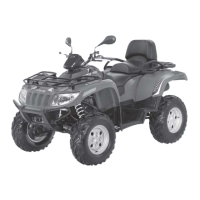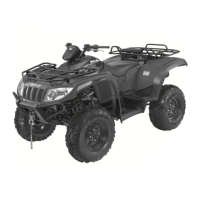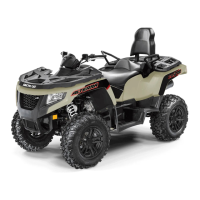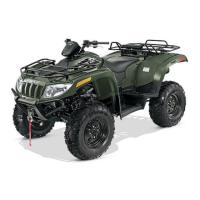Do you have a question about the Arctic Cat 700 EFI and is the answer not in the manual?
Detailed specifications for various Arctic Cat ATV models, including chassis and misc. details.
Lists torque values for various components and parts across different ATV models.
Provides a conversion chart for torque values between ft-lb and N-m.
Specifies tightening torque values for different types and sizes of bolts.
Guidance on the initial operation period for new or overhauled Arctic Cat ATVs.
Recommended types and specifications for fuel, engine oil, and gear lubricants.
Emphasizes the importance of using genuine Arctic Cat ATV parts for quality and fit.
Step-by-step instructions for preparing the ATV for storage to prevent deterioration.
Procedure to correctly prepare the ATV after a period of storage for continued use.
Comprehensive chart detailing maintenance intervals for the ATV based on time and mileage.
General notes on maintenance, special tools, and lubrication points for the ATV.
Procedure for cleaning, testing, and charging the ATV's lead-acid battery.
Locating and checking fuses in the power distribution module and replacing blown fuses.
Steps for removing, cleaning, drying, and oiling the air filter element.
Inspect and clean drain points in the filter housing and associated components.
Procedure to check and adjust valve/tappet clearance using a feeler gauge.
Procedure to adjust valve/tappet clearance using the specific valve adjuster tool.
Specific procedure to check and adjust valve/tappet clearance for 700 EFI models.
Procedure for testing engine compression using a compression tester kit.
Checking spark plug condition, gap adjustment, and cleaning for optimal performance.
Procedure to clean the spark arrester screen within the muffler assembly.
Steps to adjust the throttle cable for proper free-play at the lever.
Procedure to adjust the engine's idle RPM using a tachometer and adjustment screw.
Instructions for changing engine oil, filter, and cleaning the oil strainer.
Procedure for checking and changing lubricant in the front differential and rear drive.
Steps to adjust the clutch mechanism for proper engagement and free movement.
Guidance on tire sizes, types, and maintaining correct tire inflation pressure.
Periodic inspection of handlebars, steering post, ball joints, and tie rods for wear or damage.
Checking the driveshaft and coupling for spline movement, cracks, or wear.
Inspecting shock absorbers, rods, dampers, eyelets, and bushings for damage or wear.
Ensuring all fasteners and rivets are properly tightened to specifications.
Procedure to verify ignition timing using a timing light and tachometer.
Testing functionality of headlights, taillight, and brakelight illumination.
Procedure for adjusting the vertical and horizontal aim of the headlights.
Steps to adjust the shift lever for proper gear selection and neutral indication.
Checking the frame, welds, and racks for damage, bends, cracks, or deterioration.
Inspecting electrical connections for proper function, tightness, and corrosion.
Procedures for checking, bleeding, inspecting, and replacing parts of the hydraulic brake system.
Steps for checking fluid level and bleeding air from the hydraulic brake system.
Procedure for inspecting brake pad thickness and replacing worn pads.
Procedure to properly burnish new brake pads for optimal braking effectiveness.
Procedure for checking and adding coolant to the liquid-cooled engine.
Instructions for removing, inspecting, and installing the V-belt.
Procedure to check and adjust the differential lock cable for proper free-play.
Detailed specifications for various Arctic Cat ATV models, including chassis and misc. details.
Lists torque values for various components and parts across different ATV models.
Provides a conversion chart for torque values between ft-lb and N-m.
Specifies tightening torque values for different types and sizes of bolts.
Guidance on the initial operation period for new or overhauled Arctic Cat ATVs.
Recommended types and specifications for fuel, engine oil, and gear lubricants.
Emphasizes the importance of using genuine Arctic Cat ATV parts for quality and fit.
Step-by-step instructions for preparing the ATV for storage to prevent deterioration.
Procedure to correctly prepare the ATV after a period of storage for continued use.
Comprehensive chart detailing maintenance intervals for the ATV based on time and mileage.
General notes on maintenance, special tools, and lubrication points for the ATV.
Procedure for cleaning, testing, and charging the ATV's lead-acid battery.
Locating and checking fuses in the power distribution module and replacing blown fuses.
Steps for removing, cleaning, drying, and oiling the air filter element.
Inspect and clean drain points in the filter housing and associated components.
Procedure to check and adjust valve/tappet clearance using a feeler gauge.
Procedure to adjust valve/tappet clearance using the specific valve adjuster tool.
Specific procedure to check and adjust valve/tappet clearance for 700 EFI models.
Procedure for testing engine compression using a compression tester kit.
Checking spark plug condition, gap adjustment, and cleaning for optimal performance.
Procedure to clean the spark arrester screen within the muffler assembly.
Steps to adjust the throttle cable for proper free-play at the lever.
Procedure to adjust the engine's idle RPM using a tachometer and adjustment screw.
Instructions for changing engine oil, filter, and cleaning the oil strainer.
Procedure for checking and changing lubricant in the front differential and rear drive.
Steps to adjust the clutch mechanism for proper engagement and free movement.
Guidance on tire sizes, types, and maintaining correct tire inflation pressure.
Periodic inspection of handlebars, steering post, ball joints, and tie rods for wear or damage.
Checking the driveshaft and coupling for spline movement, cracks, or wear.
Inspecting shock absorbers, rods, dampers, eyelets, and bushings for damage or wear.
Ensuring all fasteners and rivets are properly tightened to specifications.
Procedure to verify ignition timing using a timing light and tachometer.
Testing functionality of headlights, taillight, and brakelight illumination.
Procedure for adjusting the vertical and horizontal aim of the headlights.
Steps to adjust the shift lever for proper gear selection and neutral indication.
Checking the frame, welds, and racks for damage, bends, cracks, or deterioration.
Inspecting electrical connections for proper function, tightness, and corrosion.
Procedures for checking, bleeding, inspecting, and replacing parts of the hydraulic brake system.
Steps for checking fluid level and bleeding air from the hydraulic brake system.
Procedure for inspecting brake pad thickness and replacing worn pads.
Procedure to properly burnish new brake pads for optimal braking effectiveness.
Procedure for checking and adding coolant to the liquid-cooled engine.
Instructions for removing, inspecting, and installing the V-belt.
Procedure to check and adjust the differential lock cable for proper free-play.
| Brand | Arctic Cat |
|---|---|
| Model | 700 EFI |
| Category | Offroad Vehicle |
| Language | English |












